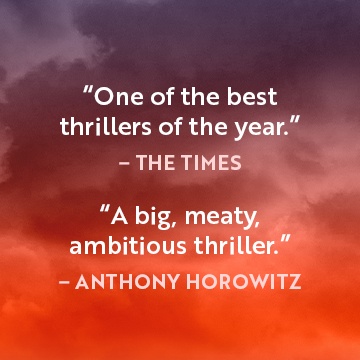
 If you’re a regular visitor to Crime Fiction Lover, chances are you consume crime novels with a passion – savouring the writing and suspense generated by your favourite authors. Perhaps you are also inspired by some of the authors we cover and are thinking of writing your own? If that’s the case, the article below is for you. We’ve invited Tim Flanagan (above), digital marketing executive at Novel Design Studio, to share his advice on how to publish your own book as part of our themed month, New Talent November. Novel Design Studio works with authors all over the world, both traditionally and self-published, helping them create and market their books. The company also publishes Westerns under the Raging Bull label, and crime fiction via Cyanide Publishing. (For more information, scroll to the bottom of this feature.) Right now, it’s over to Tim…
If you’re a regular visitor to Crime Fiction Lover, chances are you consume crime novels with a passion – savouring the writing and suspense generated by your favourite authors. Perhaps you are also inspired by some of the authors we cover and are thinking of writing your own? If that’s the case, the article below is for you. We’ve invited Tim Flanagan (above), digital marketing executive at Novel Design Studio, to share his advice on how to publish your own book as part of our themed month, New Talent November. Novel Design Studio works with authors all over the world, both traditionally and self-published, helping them create and market their books. The company also publishes Westerns under the Raging Bull label, and crime fiction via Cyanide Publishing. (For more information, scroll to the bottom of this feature.) Right now, it’s over to Tim…
How to publish your novel – seven top tips
Writing a book is the easy bit. Selling it – that’s a whole other ball game. With so many titles available in ebook, paperback, hardback and now audio format, the competition to get your book seen, let alone read, is harder than ever. This is not a get rich quick industry and whether you’re self-published, or traditionally published, chances are you’re going to have to invest your own money into your book marketing if you ever want to see it sell. With that in mind the book you lovingly created and nurtured has turned from being a creative endeavour into a commercial commodity. But if you’re serious about selling you need to start treating your writing career as a business – investing your own money, focussing on the buyer, creating a demand, and making your product desirable, whilst also developing the next product.
Here’s our top seven tips on publishing your book and getting it noticed.
1 – Create the best product you can
If your book is with a publisher most of the contents of this tip should be done for you. If you’re self published these are things you also need to do to make your book saleable.
It goes without saying that you should write the best book you can. But then pass it over to people who can do everything else better than you. A homemade book sticks out like a sore thumb – readers expect you to be serious about your book. If you believe in it and put your money behind it, they’re more likely to part with theirs too. Once your book is written, get it edited. One company we often recommend is Red Adept Editing – reasonably priced and offering a thorough job for different budgets. Next get your cover made, but make sure it’s targeted correctly. It’s better to make the cover appeal to the right audience and genre than to reflect every small nuance of the story. Then it’s formatting. The biggest complaint of reviewers after editing issues is formatting issues – the inside has to look right, especially when it’s being viewed on a digital e-reader. Don’t forget that one person could be viewing your book on a two-inch mobile phone screen, while another could be viewing it on a 10-inch tablet. Your book has to be correct on all sized devices. Same with paperbacks and hardbacks – the interior of your book must flow correctly with no stray tabs, crazy spacing, incorrect headers and footers, so get this done professionally.
2 – Focus on your target audience
Whether you’re published or self-published, you’re going to need to do some marketing yourself but before you can do it effectively you need to get to know your audience. Spend time making a list of similar authors and book titles. Then look at their websites and social media pages and see what they’re doing to connect with their audiences. Gauge whether it’s primarily a male or female audience, what films they like, what interests them. Your audience likes more than just reading – see what makes them tick. Places like Facebook make it easy to find other authors and look at their readerships. All you have to do is click on one of their posts, click on the list of people who have ‘liked’ the post and look at their profile. Build up an image of who is going to buy your book. This is important for any marketing and advertising to be effective.
3 – Create a brand
 You’re a business. Your online presence – website, blog, social media, etc – needs to have similarities to each other that are instantly recognisable as relating to you and your books. With your books, don’t change the style of the covers from one to the other. When a reader glances at a cover, they must instantly know it’s one of yours and they should then know what they’re getting before they even read the blurb. Look at the trends for style in the bestseller charts and take elements for your own.
You’re a business. Your online presence – website, blog, social media, etc – needs to have similarities to each other that are instantly recognisable as relating to you and your books. With your books, don’t change the style of the covers from one to the other. When a reader glances at a cover, they must instantly know it’s one of yours and they should then know what they’re getting before they even read the blurb. Look at the trends for style in the bestseller charts and take elements for your own.
4 – Build an online presence
You need a website that incorporates a blog. Social media pages come and go but your website is a constant that grows and expands over time. It’s the centre of your online presence where readers can find out everything about you. You might spend a lot of time on social media but the content is only temporary – pushed down on your timeline or replaced by the posts of a million other people in a news feed. Your website must look professional and present your books in the best light. Keep it clean and tidy. Avoid scrolling too much. Keep all the relevant information in one place. Don’t use the website to double up as a place to share your knitting patterns or anything else that isn’t relevant to your books. This is a place that is only for your books. Blog regularly. Two to four times a month is a good amount, and cover topics relevant to your target audience (which should be clearer after following step two, above). Don’t use your blog to keep telling your audience to buy your book – keep that to a minimum, preferably only when you have a sale or new release. Think of topics that are relevant to your books such as locations, concepts and themes, new films you know your audience will be watching, other people’s books (those more famous than you). Don’t fall into the trap of writing about your writing journey – it’s an overused approach that only appeals to writers and they’re not generally your target audience. Don’t do an author interview every week – they’re only of interest to other authors.
5 – Build a mailing list
A mailing list is an essential part of your business – it’s a list of people who have already shown an interest in your books so are much more likely to buy your next book once it’s released. Build your mailing list by giving something away. It’s no good to just say ‘join my newsletter to be kept up to date’. No one cares. Write a short story that is in a similar vein to your main books, maybe even featuring the same characters, and give it to everyone who subscribes to your mailing list. You can give them a PDF copy, but it’s more effective to give them access to an app that allows them to download a copy of the book directly onto their e-reader (whatever the make/model). Use Instafreebie or BookFunnel for this. They also deal with any difficulties a reader might have, saving you a lot of time. Set up a mailing list to store the email addresses – Mailerlite is inexpensive and good enough for this job. Inside your mailing list set up an automation sequence that is automatically triggered every time someone joins. An automation sequence is a series of emails released over time, for example the first one is a pleasant welcome email with a link to the free book, the second one gets sent out five to seven days later and politely asks what they thought of the book. After another five to seven days later maybe highlight the first book in the series or a special offer on a box set. By setting up the automation sequence you’re engaging with your audience without physically doing anything. Obtain email subscribers from your website and social media pages. Lead card ads on Facebook also work really well.
6 – Advertise
Let’s face it, your book is not likely to be accidentally found. You’ve got to forcibly put it in front of an audience. Advertising costs money (obviously) but you need to be wise about where you spend it. There are loads of websites where you can list your book for $10 to $30 – don’t bother, they’re not going to do anything for you. The most effective places to advertise tend to have their own mailing lists of readers that they mail every day with the latest offers. So, first thing, create an offer. If your book is enrolled in Amazon’s KDP Select make use of the Countdown Deal option. You can offer your book for 99c and claim 70 per cent of that as royalties (providing your book was originally $2.99 or over to start with.) Then approach places like Bookbub, Bargainbooksy, Booksends, etc to feature your book during the Countdown period. As your book climbs the chart it gets more exposure which leads to more organic sales. Also, Amazon has a dedicated page for Countdown Deals so you get more exposure there too. Sales will naturally drop after the promo period but you will have gained some new readers, increased your mailing list, and increased the traffic to your social media pages and website. Some of those new readers will also hopefully buy some of your other books (if you have some) and are also possibly going to buy your next book too.
7 – Write the next book
One book is going to achieve very little. You’ve got to get more products out there. Building a series is commercially very successful. Readers like to follow the continual adventures of your characters so will naturally invest in future books. If you want to make a living out of writing you should be aiming to produce a book every three or four months. And that’s not easy to do if you’re also trying to do all these other jobs of being an editor, formatter, cover designer, marketer, blogger, etc, etc. Your business has to have the right people working in it. Most authors can’t do everything (and some shouldn’t do everything) as well as write. Delegate jobs to those who already have the experience and knowledge and develop your business at a steady pace with solid foundations.
Novel Design Studio works with New York Times and USA Today bestselling authors all over the world, many self published, as well as traditionally published. We create book covers, format ebooks, paperbacks and hardbacks, create websites and landing pages, set up social media and mailing list accounts, and offer author management. We are always happy to provide free advice and suggestions. We also manage two publishing labels – Raging Bull Publishing (Western books) and Cyanide Publishing (Crime/Mystery books) and have pioneered the Publishing Partnership Service. Partnership authors receive a FREE online platform that includes a website, social media pages and mailing list, together with their book published in ebook, paperback and hardback (cover and formatting also included). They also benefit from 50 per cent payments towards marketing. All of this in exchange for 50 per cent of their sales royalties – a service unrivalled in the publishing world today.
For more information email designteam@noveldesignstudio.com
Also see the article by Jame Oswald on how not to self-publish your crime novel.








